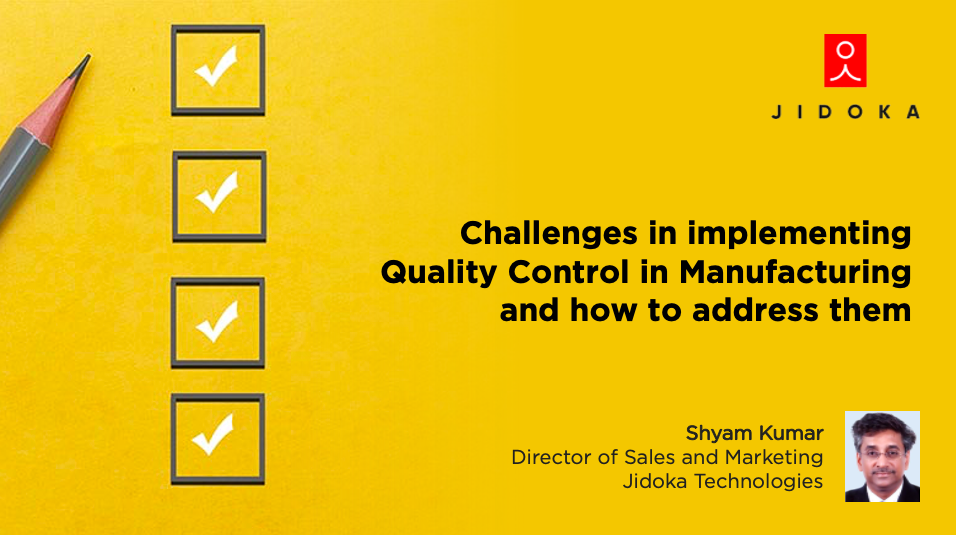Challenges in implementing Quality Control in Manufacturing and how to address them - Shyam Kumar, Director of Sales and Marketing, Jidoka Technologies

In all manufacturing setups across industry verticals, the quality of
the product is a critical aspect, more so in high-precision parts
manufacturers. Any failure to ensure superior standards of quality could result
in disasters for end customers. The quality control process which consists of
best practices to deliver products with zero defects has to be religiously
followed if the company has to remain competitive. With strict adherence to quality control
measures, manufacturers can reduce scrap, and safeguard themselves from any
damage to their brand and other losses as a result of defective products.
A robust quality control program certainly leads to better business outcomes. However, despite knowing the importance of the program, manufacturing companies witness several common mistakes that occur on their shop floor.
Not documenting the
Quality control plan
Specification setting during the manufacturing process determines the quality of the end product and has to be considered very seriously. The inspection team can use this as a reference while checking for defects and ensuring the high quality of end products while consistently maintaining quality standards. This will also come in handy during repeat orders from customers and cheap substitutes can be avoided. Specification guidelines should include product images, their dimensions, the material used, components of the product, the function, color shades, details of labeling and packaging, and any other standard specifications. All these specifications have to be well documented so the quality inspection can be efficiently performed.
Monitoring the Quality
- Presence of counting, processing, and measurement errors
- Eliminating human error and increasing productivity is essential for the smooth operations of assembly lines on the shop floor. Various errors can occur with the manual workforce, such as mistakes in the initial setup, errors in process operations where the performance is not up to the mark, incorrect measurements, and counting errors.
- Manually counting and measuring objects can be time-consuming with fatigue setting in among workers, especially in large-scale production. But still many manufacturing companies follow this inefficient method which can lead to an increase in wastage and revenue losses. AI-enabled visual inspection systems can eliminate this mistake, leading to a boost in high-quality products and an increase in throughput.
- Skewed decision-making and judgment
- The decision-making during the manufacturing quality control process leads to better product quality. However, making objective decisions can be a challenge because each individual’s judgment can be subjective based on their limited knowledge and exposure. They can also become tired or get distracted during the process leaving room for error. This challenge can be addressed by the visual inspection team developing a list of objective criteria or checklists with images or video wherever necessary and equipping assembly line workers with the standard reference for delivery of consistent decision-making. AI-based visual inspection solutions can easily solve this issue by leveraging the same parameters and delivering a consistent as well as objective view regarding quality. Decision-making with AI will significantly reduce errors in the production process leading to superior quality throughput.
- Lack of reviewing continued effectiveness
- Collecting data about the defects and consistency of decision-making is critical to evolve as processes evolve in the organization. Many manufacturers fail to adopt this practice.
Product mix-up
Manufacturing companies continue to face the
risk of mix-ups of defective products, like 1 defective product unknowingly
getting into 100,000 pieces of good product can lead to a callback. Sometimes the wrong product can get into the
wrong assembly line causing more damage going forward. These errors mostly occur when sorting is
done manually and can lead to financial and reputation losses and could give
rise to customer churn as well.
Mistake-proofing the assembly line by leveraging AI-based systems can bring about significant improvement in sorting accuracy, reduction in product mix-ups, and cost savings with lesser manpower and time is possible.
Quality Assurance
Challenges
Some manufacturers do not have a well-defined Standard Operating
Procedure to follow in their production operations, creating ambiguity that the
assembly workers have to deal with. Many
a time due to legacy systems and the absence of integration of quality data
into ERP/MIS systems, a siloed approach to Quality Assurance is taken. This
method leads to an increase in scrap, poor quality products, and growing
customer complaints, all contributing to a high Cost of Quality. The end products will not achieve the success
they deserve.
Organizations should therefore focus on good Quality Assurance Procedures to prevent errors from occurring in the first place, which is made possible with AI-based visual inspection.
Quality Control errors in manufacturing can be eliminated with
AI-powered visual inspection solutions and automated quality control processes,
promoting a culture of continuous improvement as well. The positive impact on business operations,
production management, and customer satisfaction will be visible too.



